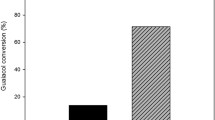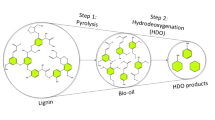Abstract
Fast pyrolysis is the most promising technique for the production of biomass-derived fuels, which is a substitute for petroleum-based fuel oil. Catalytic upgrading of pyrolysis vapours from biomass improves the quality of bio-oil to a greater extent by deoxygenation so that the upgraded bio-oil can be used as a hydrocarbon fuel. This work is mainly focused on studying the effect of various catalysts such as hierarchical HZSM-5 zeolites of different Si/Al ratios, commercial HZSM-5, and W2C/γ-Al2O3, on hydrodeoxygenation of organic compounds from pinewood pyrolysis. Catalytic hydropyrolysis experiments were conducted in an analytical pyrolyzer with ex-situ catalytic upgrading zone, which was connected to a gas chromatograph/mass spectrometer. Hierarchical zeolites exhibited significant deoxygenation activity producing aromatic hydrocarbons. The degree of deoxygenation had a good correlation with the acidity of the zeolites. Hierarchical HZSM-5 (20) produced aromatic hydrocarbons at ~88% selectivity. Furthermore, unconventional W2C/γ-Al2O3 serves as a potential hydrodeoxygenation catalyst, producing 97% selectivity to hydrocarbons. In addition, W2C/γ-Al2O3 overcomes the drawback of coke formation on acidic sites of zeolites.
Access provided by Autonomous University of Puebla. Download conference paper PDF
Similar content being viewed by others
Keywords
1 Introduction
Conversion of less valuable biomass resources into value-added fuels and chemicals not only mitigates the fossil fuel depletion, but also improves the energy recovery from renewable carbon-rich resources. Utilization of biomass as an alternative fuel aids in maintaining the carbon neutrality in the environment. Fast hydropyrolysis (FHP) involves thermochemical degradation of organic compounds in the presence of reactive hydrogen at moderate temperatures (400–600 °C) at short residence times (1–5 s), high sample heating rate (~104°C s−1) and at different partial pressures of hydrogen (1–20 bar). It has emerged as an efficient and sustainable biomass conversion technique. Fast pyrolysis results in producing ~75% of liquid product called bio-oil, which can be upgraded to fine chemicals and drop-in blendstocks. A mixture of organic compounds containing oxygen in the carbon chain is observed in bio-oil when the reactive hydrogen ambience is not employed. Unlike fossil fuels, the high amount of oxygen-containing chemical functionalities in bio-oil causes various unfavourable properties [1], which makes hydrodeoxygenation to be an imperative step in biomass conversion to hydrocarbon fuels. FHP improves the H/C ratio of bio-oil, and simultaneously decreases the O/C ratio via dehydration, decarbonylation, and decarboxylation reactions. Catalytic fast hydropyrolysis (CFHP) integrates thermal decomposition and catalytic upgrading in a single step process producing bio-oil with enhanced quality that could be utilized directly as a blendstock with transportation fuels. Catalytic upgradation of pyrolysis vapours is better than in situ biomass + catalyst fast pyrolysis, as the former method can control reaction severity, improves the deoxygenation mechanism, and also aids in better catalyst recovery.
As deoxygenation of bio-oil is an acid-catalyzed reaction, zeolites, especially HZSM-5, have been studied for aromatic hydrocarbons production from biomass via fast pyrolysis technology [2]. Light aromatic hydrocarbons, viz., benzene, toluene, xylene (BTX), are regarded as potential octane number enhancers in the petroleum industry. Nguyen et al. [3] investigated the effect of alkali on deoxygenation of pinewood pyrolysates using Na-faujasite and H-faujasite zeolites. The foremost objective of catalytic upgrading is to enhance the quality of bio-oil with greater extent of deoxygenation and minimum coke formation, without compromising on the yield of pyrolysates. Hierarchical zeolites with different levels of porosity are widely used for various catalytic applications. Co-existence of mesopores and micropores makes it more reliable compared to conventional zeolites in terms of tailoring the end products. Various catalysts such as hierarchical HZSM-5 of different Si/Al ratios (20, 40, 60), commercial HZSM-5, and W2C/γ-Al2O3 are tested in this study for deoxygenation activity via hydropyrolysis.
2 Experimental Section
2.1 Materials
Canadian pinewood purchased from ThoroughBed, Long-Beach Shavings Co. was powdered, dried, and used as the feedstock in this study. Proximate analysis of this material is reported to contain 14.5% fixed carbon, 78.4% volatile matter, 2.6% ash, 4.5% moisture on air dried basis. Ultimate analysis revealed 48.3% C, 5.8% H and 45.4% O on dry basis [4]. Hierarchical HZSM-5 of different Si/Al ratios (20, 40, 60), a commercial HZSM-5, and W2C/γ-Al2O3 were used for ex-situ upgradation of pyrolysates from thermal degradation of pinewood. The preparation and characterization details of hierarchical zeolites and W2C/γ-Al2O3 are reported in earlier studies [5, 6]. Commercial HZSM-5 was used as a reference catalyst to benchmark the pyrolysate selectivities obtained from the prepared catalysts. The salient properties of the synthesized catalysts are given in Table 1.
2.2 Fast Hydropyrolysis Experiments
Fast hydropyrolysis experiments were performed in a Pyroprobe®5200 CDS analytical pyrolyzer connected to a gas chromatograph/mass spectrometer (Py-GC/MS) (Agilent 6890 N GC and 5975 MS). Pinewood sample of mass 0.5 ± 0.005 mg taken in a quartz tube of 2 mm diameter and 20 mm length was pyrolyzed using resistively heated platinum filament, which was ramped at a heating rate of 20 °C ms−1 , and it was held at 500 °C for 30 s. Hydrogen flow was set at 15 mL min−1 in the system.
Ex-situ upgradation of evolved pyrolysates was carried out using the catalyst bed packed in a weight ratio of 6:1 (catalyst-to-biomass) inside a quartz tube maintained at 500 °C. It was then followed by a Tenax® trap to adsorb the condensable vapours and purge out the non-condensable gases. The desorbed condensable vapours from the trap at 280 °C were carried to GC inlet by helium gas at a flow rate of 1.2 mL min−1. GC injector temperature was set at 280 °C with a split ratio of 100:1. Component separation in GC was carried out using Agilent VF-1701 ms capillary column (60 m length × 250 μm diameter × 0.25 μm film thickness). The GC oven was programmed to be at 40 °C for 2 min, and then ramped to 280 °C at a rate of 3 °C min−1 with a hold time of 10 min at 280 °C. Ionization voltage of MS was set at 70 eV, and the mass-to-charge range of 33–550 Da was used to scan the pyrolysis vapours. Temperatures of MS ion source and quadrupole were set at 230 °C and 150 °C, respectively.
The identity of the organic compounds was determined by comparing the mass spectra with NIST library with high match factor (>85%). Various organic compounds obtained from GC/MS were broadly categorized into phenolics, aromatic hydrocarbons, polyaromatic hydrocarbons (PAHs), aliphatic hydrocarbons, oxygenates, and furans. Other unclassified pyrolysates were grouped under “others”. Relative area % and absolute area (normalized with initial sample mass) of every peak obtained from the total ion chromatogram (TIC) signifies the selectivity and yield of various organics, respectively. The reported data is the average of two experiments, and the typical standard deviation of individual pyrolysate selectivity was within 5–7%.
3 Results and Discussions
Figure 1 depicts the pyrolysate composition from FHP and CFHP of pinewood. FHP produced 27.9% phenols, 49.9% oxygenates and 15.8% furans. The major oxygenates include 2-butanone, acetic acid, cyclopentanone, and 2-cyclopenten-1-one. Furfural, 5-methyl furfural and 2,4-dimethyl furan were the major furan compounds. Guaiacol, phenol, cresol and methyl guaiacol were the significant phenolic compounds. Catalytically upgraded pyrolysates over hierarchical HZSM-5 catalysts of different Si/Al ratios predominantly contained aromatic hydrocarbons. As shown in Fig. 1a, HZSM-5(20) resulted in 88% selectivity to aromatic hydrocarbons. Furthermore, as the Si/Al ratio increased from 20 to 60, increased selectivity to oxygenated compounds (phenols, oxygenates, and furans) was observed. This corresponds to a gradual decrease in the selectivity to aromatic hydrocarbons, and lower deoxygenation activity as surface acidity decreased (reflected by the increase in Si/Al ratio). This is mainly attributed to the strong correlation of Brønsted acid sites with aromatic selectivity. Presence of acidic sites in the zeolite matrix strongly aids in various reactions such as hydrogen and hydride transfer, cracking, cyclization, and oligomerisation, which are imperative for the formation of hydrocarbons. HZSM-5(20) displayed similar deoxygenation activity to that of commercial HZSM-5 catalyst. From Fig. 1b, absolute yield of total pyrolysates as well as aromatics increased with increase in Si/Al ratio, suggesting the formation of coke on the acid sites. Likewise, HZSM-5 (60) resulted in high and low yields of organics and coke, respectively. Unlike HZSM-5, the use of W2C/γ-Al2O3 resulted in the production of aliphatic hydrocarbons, which are more advantageous over aromatics from the viewpoint of transportation grade fuels. Enhancement of aromatic production was achieved on addition of W2C owing to its hydrogenation/dehydrogenation activity. W2C/γ-Al2O3 is found to be superior to all HZSM-5 catalysts in terms of deoxygenation and pyrolysate yield. This is mainly due to the presence of tungsten carbide on alumina support, which is similar to a Pt-based reforming catalyst that can aid both hydrogenolysis and dehydrogenation reactions. This also emphasizes the need for metallic sites in the deoxygenation catalyst. From Fig. 1b, it is evident that the use of HZSM-5 catalysts leads to coke formation. This is reflected in low values of total peak area of the pyrolysates as compared to non-catalytic hydropyrolysis. On the contrary, high values of total peak area with W2C/γ-Al2O3 catalyst indicates the lower coke formation.
Table 2 presents the list of pyrolysates produced in FHP and CFHP over various catalysts. Xylene was the major aromatic hydrocarbon produced using hierarchical zeolites. Polycyclic aromatic hydrocarbons were more prevalent with W2C/γ-Al2O3, as compared to hierarchical zeolites as shown in Fig. 1b. Moreover, the production of naphthalene and methyl naphthalene compounds increased over W2C/γ-Al2O3. In Fig. 2, hydrocarbon selectivity vs. carbon number of pyrolysate is plotted for every catalyst. With increase in pore size, selectivity to C7 and C8 hydrocarbons increased. Hierarchical zeolites were selective to the formation of C8 hydrocarbons, whereas W2C/γ-Al2O3 favoured the production of a wide range of hydrocarbons in the C6 to C10 range.
4 Conclusion
This study demonstrates the application of hierarchical HZSM-5 as efficient deoxygenation catalysts for aromatic-rich bio-oil production. Catalyst acidity influenced the selectivity, yield as well as carbon number distribution of hydrocarbons. The activities of the hierarchical zeolites were comparable to that of commercial HZSM-5 catalyst and W2C/γ-Al2O3 catalysts. The degree of deoxygenation of various catalysts followed the trend: W2C/γ-Al2O3 (97.4% hydrocarbons) > commercial HZSM-5 (95.7%) > HZSM-5(20) (89.7%) > HZSM-5(60) (76.9%) ≈ HZSM-5(40) (74.2%).
References
Oasmaa, A., Elliott, D.C., Korhonen, J.: Acidity of biomass fast pyrolysis bio-oils. Energy Fuels 24(12), 6548–6554 (2010)
Adjaye, J.D., Bakhshi, N.N.: Upgrading of a wood-derived oil over various catalysts. Biomass Bioenergy 7(1–6), 201–211 (1994)
Nguyen, T.S., Zabeti, M., Lefferts, L., Brem, G., Seshan, K.: Catalytic upgrading of biomass pyrolysis vapours using faujasite zeolite catalysts. Biomass Bioenergy 48, 100–110 (2013)
Nguyen, T.S., He, S., Raman, G., Seshan, K.: Catalytic hydro-pyrolysis of lignocellulosic biomass over dual Na2CO3/Al2O3 and Pt/Al2O3 catalysts using n-butane at ambient pressure. Chem. Eng. J. 299, 415–419 (2016)
Parsapur, R.K., Selvam, P.: A remarkable catalytic activity of hierarchial zeolite (ZH-5) for tertiary butylation of phenol with enhanced 2,4-di-t-butylphenol selectivity. ChemCatChem 10(18), 3978–3984 (2018)
Venkatesan, K., He, S., Seshan, K., Selvam, P., Vinu, R.: Selective production of aromatic hydrocarbons from lignocellulosic biomass via catalytic fast-hydropyrolsis using W2C/γ-Al2O3. Catal. Commun. 110, 68–74 (2018)
Author information
Authors and Affiliations
Corresponding author
Editor information
Editors and Affiliations
Rights and permissions
Copyright information
© 2021 Springer Nature Singapore Pte Ltd.
About this paper
Cite this paper
Venkatesan, K., Selvam, P., Vinu, R. (2021). Hydrodeoxygenation of Bio-Oil from Fast Pyrolysis of Pinewood Over Various Catalysts. In: Bose, M., Modi, A. (eds) Proceedings of the 7th International Conference on Advances in Energy Research. Springer Proceedings in Energy. Springer, Singapore. https://doi.org/10.1007/978-981-15-5955-6_14
Download citation
DOI: https://doi.org/10.1007/978-981-15-5955-6_14
Published:
Publisher Name: Springer, Singapore
Print ISBN: 978-981-15-5954-9
Online ISBN: 978-981-15-5955-6
eBook Packages: EnergyEnergy (R0)






